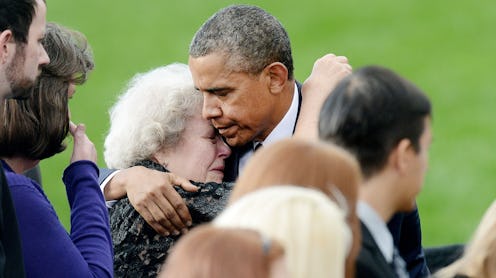News
After Navy Yard, Does Gun Control Stand a Chance?
Six days after the deadly shooting at the Navy Yard in Washington, D.C., President Obama appeared Sunday at a memorial service honoring the twelve killed last Monday by perpetrator Aaron Alexis. In a emotionally charged speech, the president spoke of his enduring commitment to gun control, saying that he feared these incidents would become "the new normal."
"It ought to be a shock to us all, as a nation, and as a people," said Obama. "It ought to obsess us. It ought to lead to some sort of transformation." He cited other Western powers — the United Kingdom; Australia — as examples of when one mass shooting had lead to drastic gun-control measures, and a sharp decline in similar shootings. "And yet, here in the United States, after the round-of-clock coverage on cable news, after the heartbreaking interviews with families, after all the speeches and all the punditry and all the commentary, nothing happens," he continued. "I fear there's a creeping resignation that these tragedies are just somehow the way it is, that this is somehow the new normal."
The president has made no secret of his emphasis on gun reform, which escalated after the Sandy Hook tragedy last December that ended the lives of 20 children and six of their teachers. An April bill that would have seen greater background checks was met with disdain by a Republican majority, and the proposal failed to pass by six votes in the Senate. An emotional Obama called it a "pretty shameful day for Washington," citing a statistic that stated more than nine in 10 Americans wanted to reform the system.
It's true that support for reformative measures peaked after the Sandy Hook tragedy, which left the entire nation in shock. But as the Guardian points out that, in spite of increasing media and administrative support of reform, everyday Americans are, as a whole, less supportive of these measures than they were in previous decades. Under Bill Clinton's presidency, for example, 57 percent favored stricter reform; under Obama, this has averaged to about 39. Obama was right to point to the "more than 90 percent" number in regard to the bill, since a January poll had found that 91 percent of Americans favored greater background checks — but analysts say that support for these measures tends to peak after high-profile shootings.
Mere hours after the news of Monday's shooting broke, the Left was already calling for another attempt to push greater gun-control measures through legislators. Still, Joe Manchin (D-W.Va.,) who championed the failed bill last year, said Sunday that he won't personally try again until there's more universal support for the measure. "Not unless there's a movement," Manchin told a CBS anchor. "You know, I'm not going to go out there and just beat the drum for the sake of beating the drum."
ThinkPolicy points out that, according to Google Trends, there isn't a movement at all. "Public awareness of the shooting has fizzled quickly," the site notes. "It seems much of the United States has moved on."
Hypothetically, what would another bill entail? The Left, according to PolicyMic, is hoping for a ban of the loosely termed "AR-15s." Except, that doesn't really make sense, continues the editorial:
In situations where AR-15s are involved, the media doesn’t even refer to them correctly. The media usually labels them “AR-15-style assault rifles.” But AR-15s are not the same thing as assault rifles. AR-15 stands for ArmaLite Rifle, named after the company that first developed it in the 1950s. AR-15s are little more than fancy looking rifles that citizens may own. “Assault rifle” refers to military weapons, generally fully automatic rifles available only to the military. The media deliberately confuses the two in order to scare the public into thinking civilians are using fully automatic weapons – which have been banned for civilian use since 1934.
Yes, shooter Aaron Alexis did use an AR-15 to kill some of his victims — but he took it from a security guard he'd already shot at the site. Initially, he went into the Navy Yard with a shotgun, which he'd purchased in neighboring Virginia. Yet, as PolicyMic notes, support to limit sales of shotguns are comparatively limited. (The essay also cites a study that said that countries with strict gun-control policies still see similar amounts of murders and suicides.)
That said, any home that doesn't have a gun doesn't have the risk that someone in the home will be shot with the gun — a risk that's 22 times greater than the gun being used in self-defense, to disable an intruder, for example. But if legislators can't agree about gun ownership, they just might be able to compromise on mental-health policies in regard to gun control. In the month before his death, Alexis had sought treatment for insomnia, and had exhibited psychotic tendencies to boot. Still, he was able to buy a gun. Legislation that would limit the access to guns for those who have presented mental-health issues has bipartisan support, meaning the mental-health angle may be the best bet for gun reform.
And the NRA's position on the shooting? Um, that there weren't enough guns. The agency's CEO, Wayne LaPierre, said that "the whole country ... knows the problem was there weren't enough good guys with guns." He added on NBC: “When the good guys with guns got there, it stopped.” LaPierre did, however, support reform of a sort: “The mental health situation in the country is in complete breakdown," he added, arguing that it was that issue which was to blame.
